Mindful Ink: How Floral Tattoos Anchor Us in the Present Moment
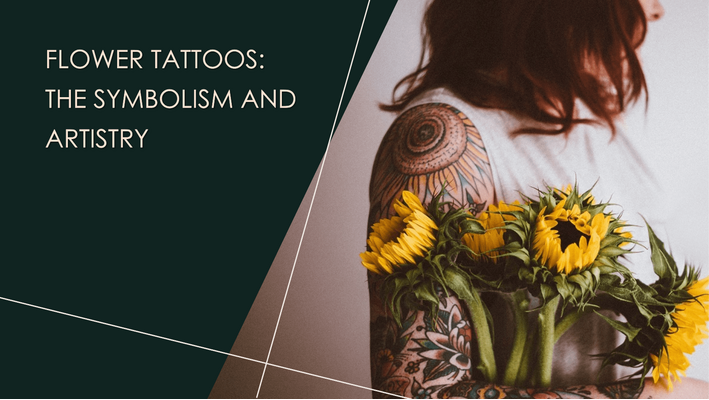
Mindfulness With Flower Tattoos
Ever noticed how a floral tattoo isn't just body art? It's a daily mindfulness practice etched into your skin. In a world where our attention constantly jumps between screens, that rose on your forearm or lotus on your shoulder can be your personal anchor to the present moment.
The Growing Popularity of Floral Ink
The global tattoo market tells the story - valued at USD 1.95 billion in 2023 and projected to reach USD 4.49 billion by 2032, growing at a CAGR of 9.7%. In the United States alone, the combined tattoo and removal industry has evolved into a $4.5 billion market. Floral designs are leading this growth, with Instagram hashtag analysis revealing impressive numbers:
- Rose tattoos: 4.3 million posts
- Peony tattoos: 649 thousand posts
- Lotus tattoos: 529 thousand posts
- Sunflower tattoos: 319 thousand posts
- Chrysanthemum tattoos: 100 thousand posts
These aren't just random preferences - they reflect our deep connection to natural symbolism.
The Psychology Behind Floral Tattoos
The stats show clear motivations: 69% of tattoo recipients cite commemoration (honouring loved ones or marking significant life events) as their primary reason for getting inked. Another 47% view tattoos as personal expression about beliefs and values, while 32% consider the cosmetic enhancement aspect.
When you choose a floral design with intention, you're creating a permanent reminder of what matters. Each glance becomes a micro-meditation, pulling you back to what's important.
Demographics: Who's Finding Mindfulness Through Ink
Currently, approximately one-third (32%) of American adults have at least one tattoo, with 22% sporting multiple pieces. Women lead in tattoo adoption at 38% compared to men at 27%, which may partly explain the popularity of floral designs. Age demographics reveal that 46% of adults aged 30-49 have tattoos, while 41% of those under 30 are inked - showing how this mindfulness practice transcends generational boundaries.
2025's Mindful Ink Trends
This year's trending styles each bring their own mindfulness vibe:
- Fine line flower tattoos are described as "probably the most popular type of tattoo we're seeing lately," offering subtle elegance for those seeking a less bold appearance
- Watercolour floral tattoos continue gaining momentum with soft, flowing colours that create a dreamy, ethereal quality
- Bold colours and high contrast floral designs are emerging as a major trend, with vivid hues and striking outlines that make floral tattoos pop
Symbolic Gardens on Skin
Your choice of flower carries deeper meaning that can support specific mindfulness practices:
- Roses symbolize love, beauty, and sacrifice, with different colours conveying specific meanings—red for passion, white for purity, and black for loss
- Lotus flowers represent purity, enlightenment, and rebirth, drawing from their natural growth journey from muddy waters to immaculate blooms
- Cherry blossoms symbolise the transience of life, beauty, and life's cyclical nature, particularly in Japanese culture
- Dandelions represent freedom, hope, and wishes coming true, appealing to those seeking symbols of resilience and positivity
The Universality of Floral Symbolism
Floral tattoos convey a universal language of symbolism that resonates across cultures. The meanings behind these tattoos are influenced by cultural contexts, echoing the deep-seated beliefs and traditions of societies around the globe.
For instance, in our article on flower-inspired baby names, we explored how flowers like the Lily, Rose, and Daisy have different symbolic interpretations across cultures, a characteristic that is also reflected in their usage in tattoos.
Popular Floral Tattoo Designs and Their Meanings
Arguably one of the most recognized flowers in tattoo art, roses symbolize:
Different colors carry unique meanings:
- Red: Love and passion
- White: Purity and new beginnings
- Black: Loss and mourning
- Pink: Grace and joy
With roots in muddy waters that bloom into beautiful flowers, lotus tattoos represent:
Colors carry significant meanings:
- White: Mental and spiritual purity
- Red: Love and compassion
- Blue: Wisdom and knowledge
- Pink: Divine birth
Known as "sakura" in Japan, cherry blossoms embody the concept of "mono no aware" (beauty of impermanence):
These short-lived blooms remind us:
- Life is fleeting and precious
- Beauty exists in impermanence
- Nature's ongoing cycle of renewal
- Living fully in the present moment
Floral Tattoo Styles: From Traditional to Modern
Also known as "Old School" tattoos, popularized in the early 20th century by artists like Sailor Jerry.
An evolution of traditional style that maintains core elements while adding modern techniques.
Simple, elegant designs that capture the essence of flowers with minimal elements.
Modern approach that transforms organic floral shapes into angular, mathematical forms.
Popularity of Floral Tattoo Types & Styles
Each flower carries its distinct symbolism and meaning, making the choice of a floral tattoo an intensely personal one. Here are a few examples:
Rose Tattoos: Love, Beauty, and Sacrifice
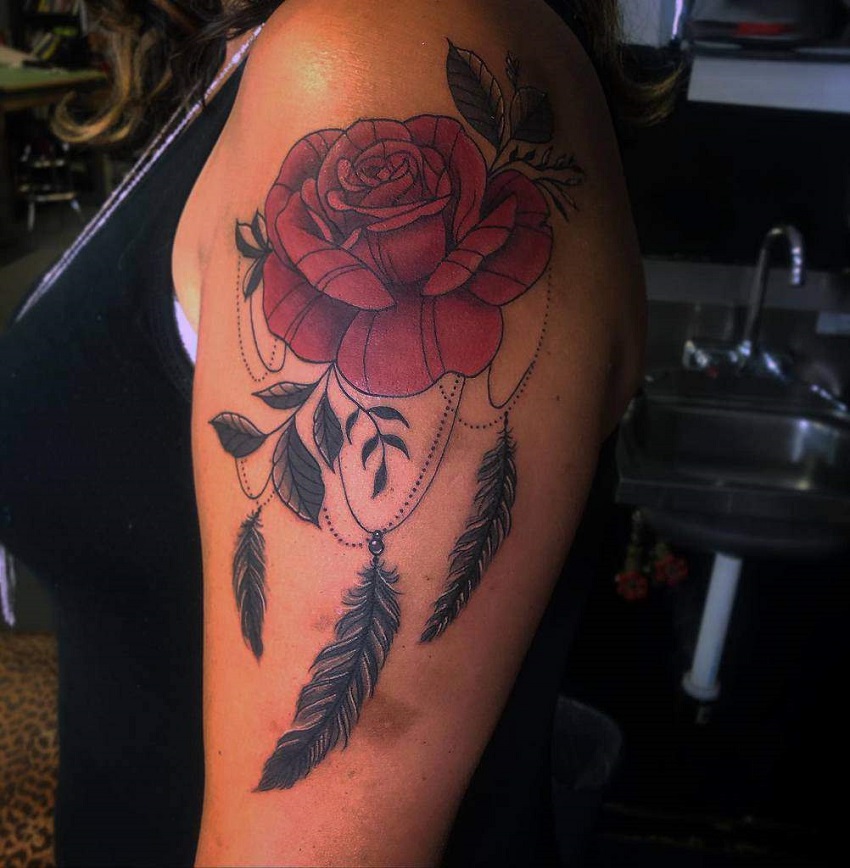
*Image credit: NextLuxury
Arguably one of the most well-recognised flowers in the world, the rose is a classic symbol of love, beauty, and sacrifice. In the realm of floral tattoos, the rose stands as an enduring favourite, beloved for its intricate details, dramatic thorns, and striking colours.
In their various hues, rose tattoos capture a spectrum of human emotion and experience. Red roses, for instance, are synonymous with love and passion, often used as a testament to deep romantic feelings or a powerful bond. Our blog post on romantic flower gifts delves into the romantic symbolism of roses and other flowers, adding depth to the understanding of this classic tattoo choice.
In contrast, white roses signify purity, innocence, and new beginnings, making them an excellent choice for those embarking on a fresh start or commemorating a significant life change. Our article on wedding flowers explores the role of white roses in symbolising new beginnings, a concept that can be beautifully represented through a white rose tattoo.
Black roses, on the other hand, represent loss, grief, and mourning, providing a poignant way to memorialise a loved one or commemorate a period of hardship. In our blog post about funeral service flower etiquette, we discuss the symbolism of black roses in depth, illustrating their significance as a tattoo choice.
But rose tattoos are not limited to these traditional colour interpretations. Pink roses symbolise grace, admiration, and joy, while orange roses denote enthusiasm and excitement. Similarly, blue roses, though not naturally occurring, are often associated with mystery and achieving the impossible.
Beyond their colours, the structure of a rose tattoo can also carry meaning. A rose bud may symbolise new beginnings or potential, while a fully bloomed rose could represent maturity and fulfilment. The presence of thorns can add an element of sacrifice and defence, reminding us that beauty often comes with its share of trials and hardships.
In terms of style, rose tattoos can be rendered in a variety of ways, from traditional and neo-traditional designs with their bold lines and vibrant colours, to realistic or hyper-realistic versions that capture the flower's natural beauty with stunning accuracy. For a more modern and abstract take, watercolour or geometric rose tattoos offer a unique and visually compelling option.
In essence, a rose tattoo, much like the flower itself, is rich in symbolism and versatility. It's a timeless design that can be personalised in countless ways to reflect your own story and experiences, making it a beautiful and meaningful choice for body art.
Lotus Tattoos: Purity, Enlightenment, and Rebirth
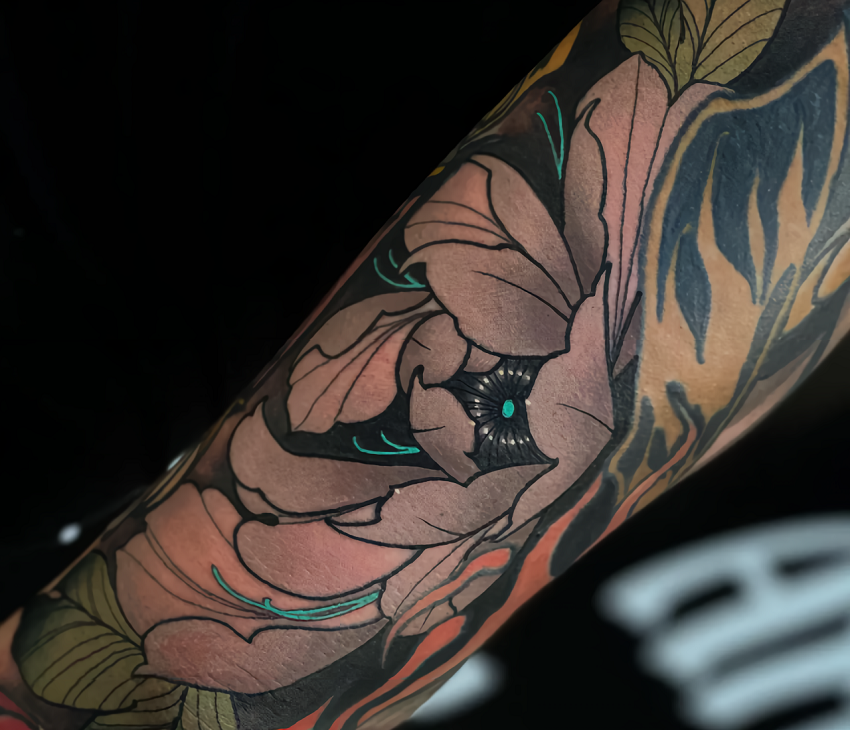
*Image credit: Deviant Art
The lotus flower holds a special place in various cultures around the globe, often seen as a symbol of purity, enlightenment, and rebirth. It's a popular choice for tattoos, carrying a profound symbolism that resonates deeply with many individuals.
The lotus has a unique life cycle. It sprouts in muddy waters and gradually rises above the surface, blooming into an immaculate flower. This growth journey from darkness to light has been interpreted as a metaphor for human spiritual growth and enlightenment. This is further explored in our blog post on creative flower decorating where the lotus flower plays a significant role as a symbol of spiritual awakening.
Lotus tattoos can be a beautiful representation of personal transformation, resilience, and the ability to rise above adversity. The tattoo can be a powerful reminder of one's strength and the potential for growth and renewal, no matter the circumstances.
In Buddhism, the lotus is associated with purity of body, speech, and mind. The flower's ability to remain untouched by the mud from which it grows symbolises the potential for spiritual purity amid worldly suffering. Tattooing a lotus can thus serve as a constant reminder of one's commitment to spiritual growth and purity.
The colour of a lotus tattoo can also convey different meanings. A white lotus is typically associated with mental and spiritual purity, while a red lotus symbolises love, compassion, and the heart. A blue lotus, often depicted as partially closed, signifies the universe's infinite wisdom, while a pink lotus is considered sacred to Buddha, representing divine birth and spiritual development.
Lotus tattoos can be designed in numerous styles, each adding a unique aesthetic flair to the symbol's profound meaning. Traditional and neo-traditional lotus tattoos often feature bold outlines and vibrant colours, emphasising the flower's beauty and symmetry. Realistic and hyper-realistic designs, on the other hand, capture the lotus's natural elegance in exquisite detail.
For those seeking a more modern or abstract representation, watercolour lotus tattoos offer a dreamy, ethereal quality, while geometric designs can highlight the flower's symmetrical beauty. The lotus can also be combined with other elements such as mandalas or symbols to further enhance its meaning.
A lotus tattoo offers a wealth of symbolic meanings, from personal transformation to spiritual enlightenment. Its beauty, resilience, and profound cultural significance make it a compelling choice for body art, a beautiful embodiment of the wearer's journey and values.
Cherry Blossom Tattoos: Transience, Beauty, and the Cycle of Life
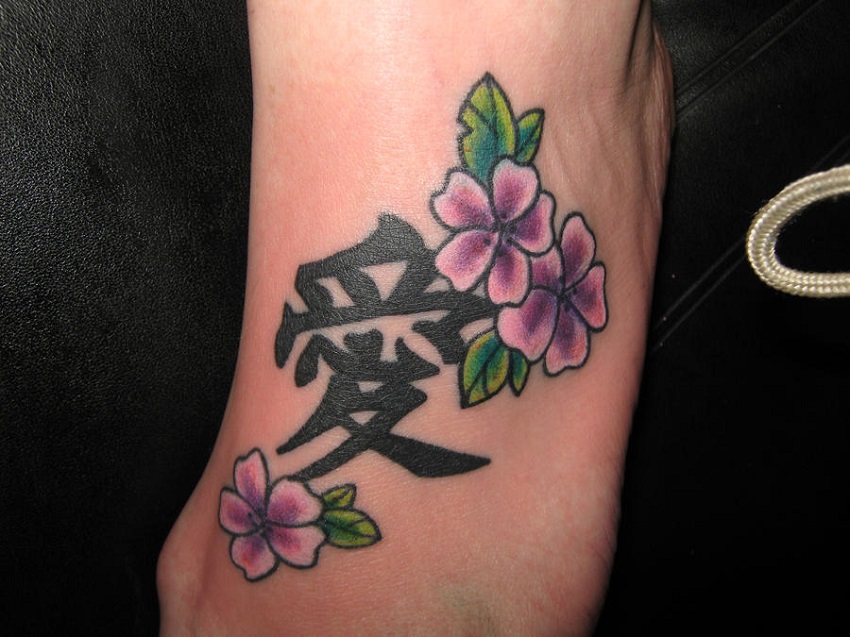
The cherry blossom, or sakura, is an exquisite flower renowned for its beauty and fleeting lifespan. This delicate bloom has a rich symbolic history, particularly in Japanese culture, where it represents the fleeting nature of life, the beauty of transience, and the cyclical progression of life. As such, cherry blossom tattoos have become a popular choice for individuals seeking to capture these themes in their body art.
The cherry blossom’s life cycle is notably brief. The flower reaches full bloom in just a week, only to shed its petals soon after. This short-lived spectacle has long been associated with mono no aware, a Japanese concept that appreciates the beauty of ephemeral things. In a cherry blossom tattoo, this symbolises the fleeting nature of life and the need to appreciate each moment. Our blog post on flower-inspired baby names discusses the significance of the cherry blossom in more detail.
Cherry blossom tattoos are often chosen as a reminder of the transience of life, as well as the beauty found within it. They can serve as a poignant reminder to live in the present, appreciate the beauty around us, and to understand the natural cycle of life and death.
The cherry blossom also represents renewal and the cycle of life. As the flowers bloom each year, they symbolise the constant renewal of life, making these tattoos a symbol of resilience and hope for the future. This theme is further explored in our article on spring flowers, detailing the cherry blossom's role as a harbinger of spring and renewal.
In terms of design, cherry blossom tattoos can be as simple or as intricate as the wearer desires. A single blossom can serve as a delicate, minimalist piece, while a branch laden with blossoms can make for a more complex and eye-catching design. Similarly, the tattoo can be rendered in a variety of styles – from traditional and neo-traditional to realistic or watercolour designs.
Cherry blossoms are often depicted in soft pinks, though they can also be rendered in black and grey for a more subdued effect. The addition of falling petals can add a sense of movement to the piece, further emphasising the flower's transient nature.
In essence, cherry blossom tattoos serve as beautiful reminders of life's fleeting beauty and the cyclical nature of existence. They encapsulate a deep appreciation for each transient moment and the ever-present cycle of renewal, making them a meaningful and visually stunning choice for a tattoo.
Floral Tattoo Styles: From Traditional to Modern
The style of a floral tattoo can dramatically alter its visual impact. From traditional and neo-traditional designs to minimalist and geometric ones, the choice of style is as personal as the choice of flower.
Traditional and Neo-traditional Floral Tattoos
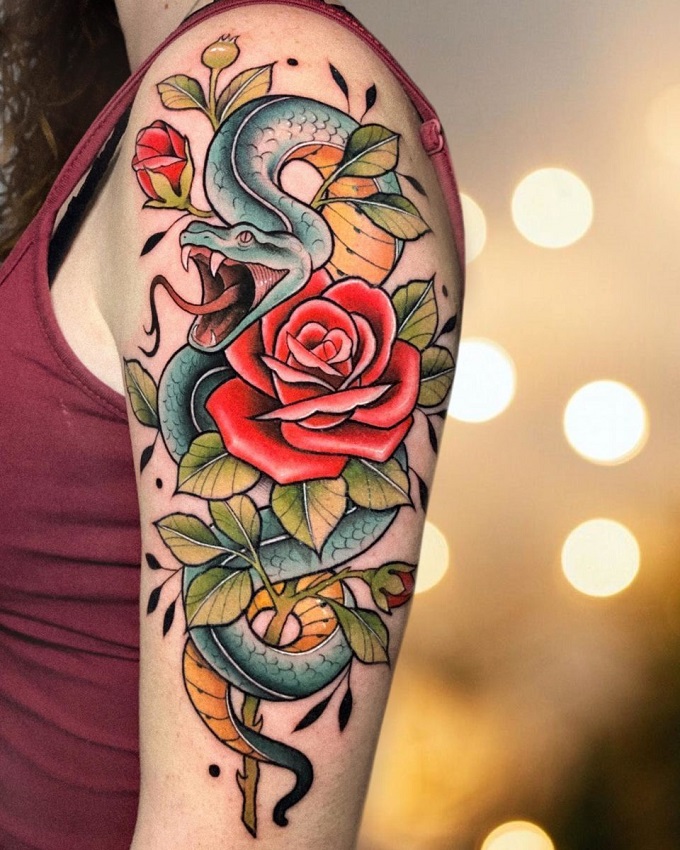
*Image credit: Mamas Uncut
Traditional and neo-traditional tattoos have a long-standing history within the world of body art. They are admired for their bold, vibrant designs and timeless appeal. When it comes to floral tattoos, these styles can enhance the flowers' inherent beauty while adding a classic touch.
Traditional tattoos, also known as 'Old School', emerged in the early 20th century, characterised by their bold black outlines, solid fill colours and a lack of fine details. The iconic style was popularised by tattoo artists such as Norman 'Sailor Jerry' Collins, who crafted designs that were simple yet striking. Traditional floral tattoos often feature popular flowers such as roses, lotus, and cherry blossoms, drawn with a strong emphasis on shape and colour rather than intricate detail. If you're interested in the historical significance of these flowers, our blog on the symbolic meaning of funeral flowers offers a deeper insight.
Neo-traditional tattoos, as the name suggests, are an evolution of the traditional style. They maintain the bold outlines and vibrant colours of traditional tattoos but introduce more complexity and detail into the design. The result is a visually stunning tattoo that combines the best of old and new. Floral designs in the neo-traditional style often feature a wider range of flowers, from roses and lilies to more exotic blooms, each rendered with a depth and detail that brings the flower to life. Our blog post on gardening with Australian native flowers offers a glimpse into some of the unique blooms that can be captured in this style.
Both traditional and neo-traditional floral tattoos can be customised to suit the wearer's preferences. Size, colour, and additional elements can all be adjusted to create a unique piece of body art that captures the wearer's personality and the flower's symbolic meaning. Whether you're drawn to the simplicity and boldness of traditional tattoos, or the intricate detail of neo-traditional designs, these styles offer a timeless approach to floral body art. They serve as a vibrant reminder of nature's beauty, a personal symbol, or a piece of art to be admired.
Minimalist and Geometric Floral Tattoos
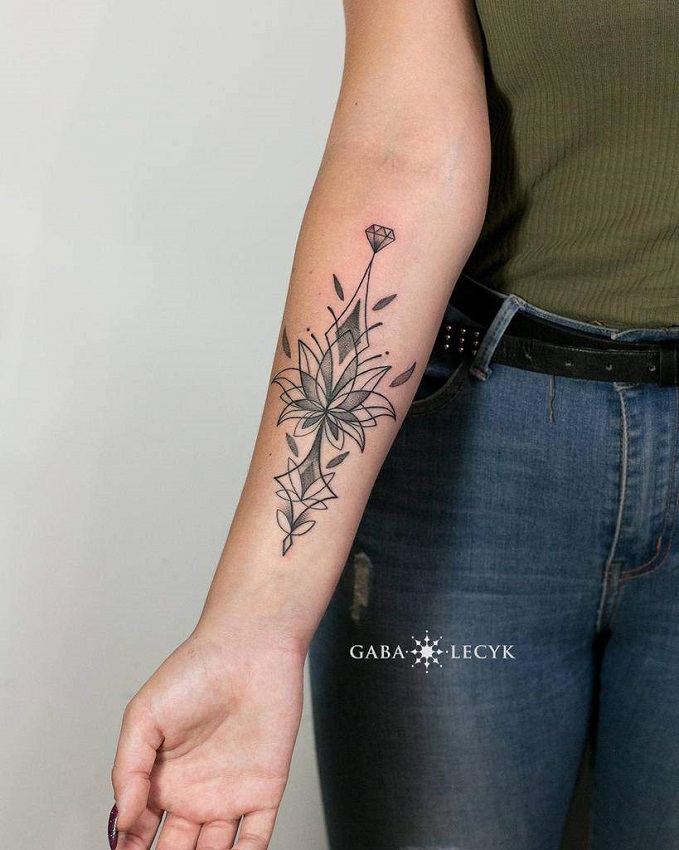
*Image credit: NextLuxury
While some prefer the bold vibrancy of traditional styles, others are drawn to the understated elegance of minimalist and geometric floral tattoos. These designs are characterised by their simplicity and precision, offering a contemporary take on floral body art.
Minimalist floral tattoos strip down the design to its bare essentials, often featuring a single line or a simple outline to depict the flower. This style focuses on simplicity and subtlety, creating a delicate and discreet piece of body art. Popular minimalist floral designs often include single stem flowers, such as roses or lilies, drawn with a single continuous line or a simple outline. For inspiration on minimalist flower designs, our blog post on creative flower decorating offers some unique ideas.
Minimalism often merges with another popular tattoo style: geometric. Geometric floral tattoos integrate shapes, lines, and angles into the design, creating a stylised, abstract version of the flower. This style adds a modern, artistic twist to the natural beauty of flowers. A geometric rose, for instance, might be made up of triangles and straight lines, transforming the classic bloom into an intriguing piece of art. You can find more on the rose's symbolism in our blog post about extending the vase life of roses.
Both minimalist and geometric floral tattoos are versatile in terms of placement due to their generally smaller size. They can be easily adapted to fit on the wrist, ankle, behind the ear, or any other discreet location. In spite of their simplicity, these designs can still carry a wealth of meaning. The flower chosen, the design's simplicity or complexity, and even the location of the tattoo can all contribute to its personal significance.
In essence, minimalist and geometric floral tattoos offer a modern, understated alternative to more traditional styles. They capture the essence of floral beauty in a unique and artistic way, creating a personal piece of body art that can be appreciated for both its aesthetics and its symbolism.
Choosing the Right Floral Tattoo for You
Selecting the perfect floral tattoo can be a thrilling, albeit challenging, experience. It's a personal journey that requires careful consideration, from understanding the symbolic language of flowers to pinpointing the right style and placement for you.
One of the initial steps towards choosing the right floral tattoo is understanding what different flowers represent. Each bloom carries its own unique symbolism, often influenced by cultural, historical, and personal contexts. For instance, the rose is commonly associated with love and beauty, whereas the lotus symbolises purity and rebirth. Our blog post on flower-inspired baby names offers an engaging exploration into the meanings behind various flowers.
Personal and cultural meanings should also factor into your decision. A floral tattoo might be chosen to commemorate a significant life event, to honour a loved one, or to represent a personal attribute or aspiration. Cultural contexts can also shape the symbolism of floral tattoos, as flowers can carry specific meanings in different societies. For example, the chrysanthemum is considered a symbol of death in some cultures but is associated with joy and longevity in others, as discussed in our blog post about the birth month flower chrysanthemum.
Next, consider the style that resonates with you. From the bold and vibrant colours of traditional and neo-traditional tattoos to the understated elegance of minimalist and geometric designs, there's a wealth of styles to choose from. Each offers a unique way to express your individuality through body art.
Deciding on the right placement for your tattoo is another key consideration. The location of your tattoo can enhance its symbolism and impact. Smaller, more discreet locations might be suited to delicate, minimalist designs, while larger areas can accommodate more detailed and intricate floral tattoos.
Choosing the right floral tattoo involves a thoughtful balance of symbolic understanding, personal resonance, style preference, and thoughtful placement. It's a personal journey, a form of self-expression, and an opportunity to carry a piece of nature's artistry with you wherever you go.
Getting Your Floral Tattoo: The Process

Once you've decided on the perfect floral design, the journey to getting your floral tattoo begins. This process involves several important steps, from finding a skilled tattoo artist to understanding the aftercare procedures necessary to keep your tattoo looking its best.
The first step is finding a tattoo artist whose style aligns with your vision. It's worth spending time researching different artists, checking their portfolios, and reading reviews from previous clients. Remember, not all tattoo artists specialise in the same styles, so it's important to find one who has experience and expertise in the style you've chosen for your floral tattoo.
Once you've found the right artist, the next step is the consultation. This is an opportunity to discuss your design, placement, and size preferences, as well as any questions or concerns you might have. Be sure to communicate your ideas clearly, but also be open to the artist's suggestions. They bring a wealth of experience and might offer insights that could enhance your design or improve the tattooing process.
The actual tattooing process can vary depending on the complexity of your design and your pain tolerance. Be prepared for some discomfort, but remember that it's all part of the process. Your tattoo artist should make you feel as comfortable as possible, explaining each step of the process as they go.
Aftercare is the final, and arguably most important, step in getting a floral tattoo. Proper aftercare ensures that your tattoo heals correctly and looks its best. This usually involves keeping the tattoo clean, avoiding direct sunlight, and applying a specific lotion or ointment. Your tattoo artist will provide detailed aftercare instructions tailored to your specific tattoo.
The process of getting a floral tattoo is a unique journey, a blend of anticipation, excitement, and ultimately, satisfaction. From the initial consultation to the careful aftercare, each step brings you closer to the moment when you can proudly display your new piece of body art. And remember, each tattoo tells a story. Your floral tattoo is not just a beautiful design, but a personal symbol, a work of art etched into your skin that will accompany you on your life's journey.
The Timeless Appeal of Floral Tattoos
Floral tattoos offer a unique blend of artistry and symbolism, serving as a conduit for personal expression and cultural storytelling. They allow us to wear our beliefs, passions, and narratives on our skin, offering a visual representation of our inner world. Whether you are drawn to the classic allure of a rose or the spiritual resonance of a lotus, a floral tattoo is a deeply personal and meaningful choice.
Dandelion Tattoos: Freedom, Hope, and Wishes Come True
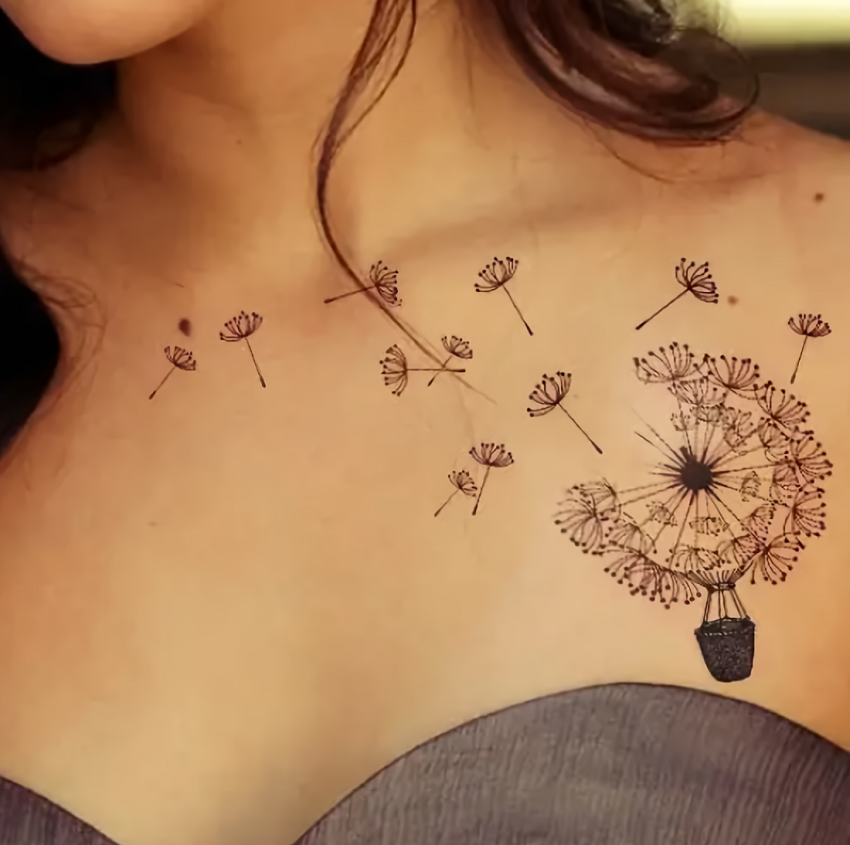
*Image credit: Allowomenstalk
Dandelion tattoos are rapidly growing in popularity, embraced for their simple beauty and profound symbolism. These seemingly humble blooms carry a wealth of meaning, embodying themes of freedom, hope, and the fulfilment of wishes.
Traditionally, the dandelion has been associated with a variety of positive meanings. As children, many of us will have picked a dandelion clock, closed our eyes, and blown the seeds into the wind while making a wish. This act has cemented the dandelion as a symbol of wishes coming true. In addition to this, the dandelion's ability to thrive in difficult conditions makes it a symbol of resilience and survival.
In the realm of tattoos, a dandelion often symbolises the ability to rise above life's challenges. This is beautifully portrayed in designs where the seeds are shown dispersing into the wind, embodying a sense of freedom and liberation. Such designs could represent a significant life change or personal growth, symbolising the wearer's ability to move on and start anew.
Dandelion tattoos also embody a sense of hope and positivity. Just as the dandelion seeds are carried off into the unknown, they carry with them the potential for new growth and opportunities. For those with a hopeful outlook on life, a dandelion tattoo could be a perfect fit.
These designs can be styled in a variety of ways, from realistic, detailed depictions to minimalist, single-line drawings. Some might choose to incorporate other elements into the design, such as birds or butterflies, which can enhance the tattoo's symbolism.
Despite its humble appearance, the dandelion is a powerful symbol of freedom, hope, and the power of dreams. Whether it serves as a reminder of personal growth, a symbol of hope for the future, or a testament to resilience, a dandelion tattoo can be a meaningful addition to your body art collection.
In the world of flowers, dandelions may not have the romantic allure of roses or the exotic appeal of lotuses, but they have a charm all their own. As we've explored in our blog about gardening with Australian native flowers, even the most unassuming of flowers can hold a special significance. The same is true for dandelions, making them a deeply personal and surprisingly poetic choice for a floral tattoo.
Realistic and Hyper-realistic Floral Tattoos
In the vast and diverse world of floral tattoo styles, realistic and hyper-realistic designs hold a special place. These designs require a high level of skill and precision, resulting in tattoos that are incredibly lifelike and detailed.
Realistic floral tattoos strive to capture the natural beauty of flowers as accurately as possible. Rather than using stylised or abstract interpretations, these designs aim to represent the flower in a way that is true to life. This style requires a deep understanding of the anatomy of flowers, from the texture of the petals to the subtle shifts in colour. The result is a tattoo that looks as though a real flower has been delicately pressed onto the skin.

Hyper-realistic floral tattoos take this concept even further. This style involves not only capturing the intricacies of the flower itself but also creating a sense of depth and dimensionality. By incorporating elements such as shadow and light, a skilled tattoo artist can create a design that appears almost three-dimensional on the skin. Hyper-realistic floral tattoos often look so lifelike that they could be mistaken for a photograph or a finely detailed painting.
Both realistic and hyper-realistic floral tattoos offer a wonderful opportunity to showcase the natural beauty of your chosen flower. This style can be particularly effective for those who have a strong personal connection to a specific type of flower. For example, if you're particularly fond of roses, a realistic rose tattoo can capture the beauty and symbolism of this iconic bloom, as we've discussed in our blog on the top 6 rose varieties to grow in your garden.
However, it's important to note that realistic and hyper-realistic floral tattoos require a high level of skill and expertise. If you're considering this style, it's crucial to find a tattoo artist who specialises in realistic designs and has a portfolio that demonstrates their proficiency in this area.
In conclusion, realistic and hyper-realistic floral tattoos are a stunning choice for those who appreciate the natural beauty of flowers. With their intricate details and lifelike appearance, these tattoos can be a beautiful and meaningful addition to your body art collection.
Watercolour Floral Tattoos
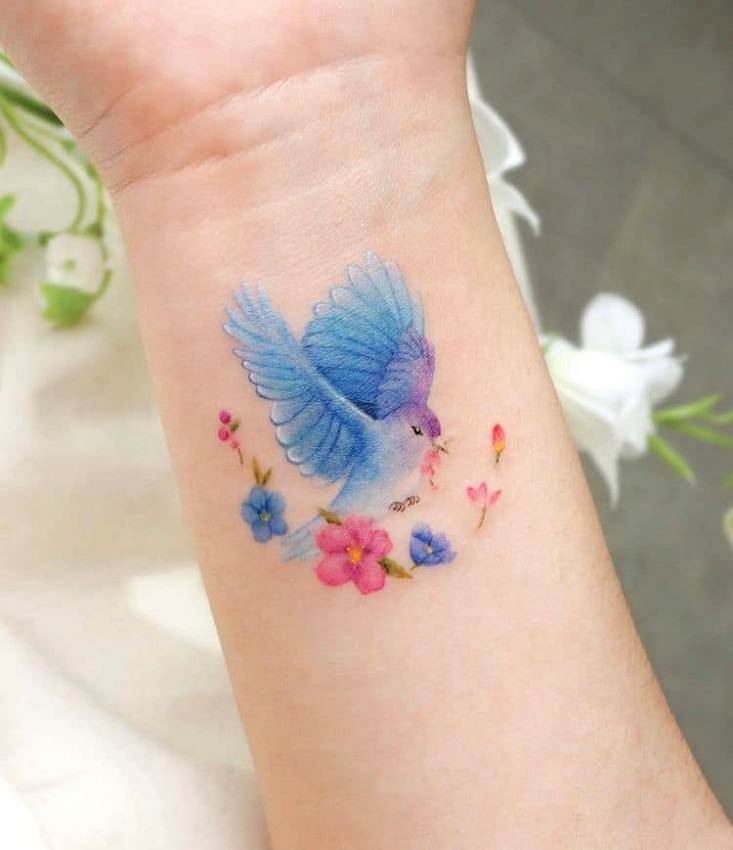
*Image credit: My Modern Met
Watercolour tattoos are an increasingly popular style in the world of tattoo artistry, and floral designs lend themselves exceptionally well to this technique. Characterised by their soft, flowing colours and absence of bold, black outlines, watercolour tattoos can mimic the delicate beauty of a painting, making them a uniquely artistic choice for body art.
Watercolour floral tattoos capture the essence of flowers in a dreamy, ethereal way. The colours blend seamlessly into each other, just as they would on a canvas, emulating the vibrant hues and delicate shading found in nature. The designs often feature splashes of colour, drips, and a 'washed out' effect, much like a watercolour painting.
The designs can range from highly detailed to abstract, allowing for a great deal of creativity and personalisation. For instance, a watercolour rose tattoo could feature a realistic rose surrounded by abstract splashes of colour, representing love and beauty amidst chaos, a concept we discussed in our blog on rose varieties to grow in your garden.
Watercolour floral tattoos offer a softer and more whimsical alternative to traditional tattoo styles. However, due to their intricate and detailed nature, they should ideally be undertaken by a tattoo artist skilled in this particular technique.
One consideration to keep in mind with watercolour tattoos is their longevity. Some believe that without black outlines to keep the colours contained, there may be a risk of colours fading or blurring over time. However, with proper care and potential touch-ups, a watercolour tattoo can remain vibrant for many years.
In conclusion, watercolour floral tattoos are a beautiful, artistic choice for those seeking a unique, vibrant, and expressive piece of body art. They capture the delicate beauty of flowers in a style that is as transient and ethereal as nature itself.
Tribal and Blackwork Floral Tattoos
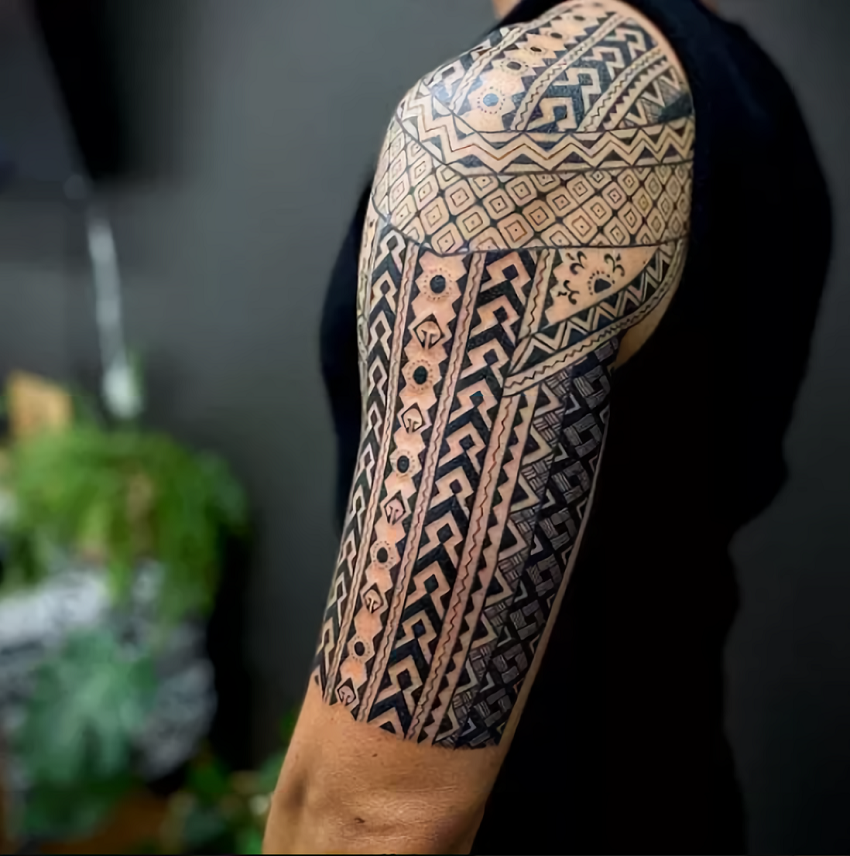
*Image credit: Fashion Beans
Tribal and blackwork floral tattoos offer a bold and striking contrast to the softer, more delicate styles of floral tattoo art. Rooted in ancient traditions and cultures, these tattoo styles use heavy black ink and strong, defined lines to create designs that are as visually striking as they are meaningful.
Tribal floral tattoos are inspired by the tattoo traditions of indigenous cultures from around the world, such as the Polynesian, Māori, and Native American tribes. These designs often incorporate floral motifs, which have significant cultural symbolism. For instance, in Polynesian tattoo art, the hibiscus flower represents femininity and natural beauty.
A tribal floral tattoo is typically characterised by bold black lines, geometric patterns, and symmetry. Despite their boldness, tribal designs can capture the essence of flowers in a unique and stylised way. For example, the tribal interpretation of a lotus flower can encapsulate its symbolic associations with purity and rebirth, a theme explored in our previous article on Lotus Tattoos: Purity, Enlightenment, and Rebirth.
Blackwork floral tattoos, on the other hand, refer to designs that are filled in entirely with black ink. This style can range from completely solid black areas to intricate patterns and textures. Blackwork floral tattoos often use high contrast and negative space to create visually striking designs. For instance, a blackwork rose tattoo might use solid black for the petals, with negative space outlining the flower's form and details.
Both tribal and blackwork floral tattoos can make a powerful statement due to their bold and distinctive aesthetic. However, they also require a high level of skill and precision to execute correctly. As such, it's crucial to find a tattoo artist who specialises in these styles.
In conclusion, tribal and blackwork floral tattoos offer a bold, striking alternative for those seeking to express their appreciation for nature's beauty through body art. Despite their intensity, these designs can encapsulate the symbolism and artistry of floral motifs in a unique and impactful way.
Understanding What Different Flowers Represent
Universally recognized symbols with meanings that vary by color:
- Red: Passionate love and desire
- Yellow: Friendship and joy
- White: Purity and innocence
- Pink: Gratitude and admiration
Different types of lilies carry unique symbolism:
- Calla Lily: Beauty and magnificence
- Stargazer Lily: Ambition and success
- Easter Lily: Hope and renewal
With their bright yellow petals that follow the sun, sunflowers represent:
- Happiness and optimism
- Strength and warmth
Emerges clean from muddy waters, symbolizing the journey to spiritual awakening:
- White: Mental purity and spiritual perfection
- Pink: Buddha and divine birth
- Purple: Mysticism and spirituality
- Red: Compassion and love
Blooming briefly each spring, cherry blossoms (sakura) represent:
- The fleeting nature of life and beauty
- Renewal and the cycle of seasons
From bright yellow flowers to wispy seed heads, dandelions represent:
- Resilience and perseverance
- Wishes and dreams carried on the wind
Understanding the symbolism and meanings behind different flowers can significantly enrich your floral tattoo choice. Each flower carries a distinct symbolism, shaped by cultural, historical, and even personal contexts. This knowledge allows you to select a design that not only appeals aesthetically but also resonates with you on a deeper, more personal level.
Let's delve into the symbolism of some popular flowers often used in tattoo art:
- Roses, as we've previously discussed, are universally recognised symbols of love, beauty, and sacrifice. Different coloured roses also carry specific meanings - a red rose symbolises passionate love, a yellow rose stands for friendship, while a white rose denotes purity.
- Lilies symbolise purity and passion. Different types of lilies can carry different meanings. For instance, the Calla Lily, often seen in wedding flower arrangements, represents beauty, while Stargazer Lilies are associated with ambition and success.
- Sunflowers, with their bright yellow petals, are symbols of adoration, loyalty, and longevity. They're often associated with the sun and its life-giving warmth.
- Lotus flowers represent purity, enlightenment, and rebirth, as they emerge beautifully clean from the muddy waters they grow in. They're highly significant in Buddhist and Hindu cultures.
- Cherry Blossoms symbolise the transience of life, beauty, and the cycle of life. In Japanese culture, they represent the fleeting nature of beauty and life.
- Dandelions, often associated with childhood and innocence, symbolise freedom, hope, and wishes coming true.
Understanding the symbolism of different flowers allows you to make a more informed decision about your floral tattoo. It's not just about choosing a design you find visually appealing, but also about understanding the deeper meanings and symbolism behind it. After all, your floral tattoo will be a part of you, carrying its symbolism wherever you go. By understanding what different flowers represent, you ensure that your tattoo resonates with your personal beliefs, experiences, or aspirations, making it all the more special and meaningful.
Considering Personal and Cultural Meanings
The selection of your floral tattoo should not only be guided by the inherent symbolism of the flower but also your personal experiences and cultural background. This is where the art of tattooing becomes incredibly personal and unique to each individual.
Personal meanings could be tied to experiences, memories, or individuals that hold a significant place in your life. For instance, you might choose a rose tattoo not just for its universal symbol of love, but because it reminds you of your grandmother's rose garden where you spent countless childhood summers. Perhaps sunflowers are your best friend's favourite flower, and having a sunflower tattoo is a token of your enduring friendship.

Cultural meanings, on the other hand, can be complex and diverse, as the same flower can hold different symbolic meanings across different cultures. Take the lotus flower, for example. In Hinduism, the lotus is associated with divine beauty and purity, with the unfolding of its leaves representing the expansion of the soul and spiritual awakening. In contrast, in Egyptian culture, the lotus symbolises the sun and rebirth, as it closes at night and opens again at dawn.
It's important to be respectful and mindful when incorporating symbols from cultures different from your own. Always do your research and consider the cultural significance of the symbols you choose to avoid misappropriation and to ensure your tattoo respects and honours the cultures they originate from.
While understanding the general symbolism of different flowers is a good starting point, the personal and cultural meanings you associate with these symbols can add depth and personal significance to your floral tattoo. Your floral tattoo, therefore, becomes a unique reflection of your personal story, cultural heritage, and the values you hold dear.
Deciding on the Right Style and Placement
The style and placement of a floral tattoo can dramatically affect its visual impact and personal resonance. Our article on bridal bouquets, for example, explores how placement and arrangement can transform the symbolism and aesthetic of a selection of flowers. These principles can similarly be applied when deciding on the style and placement of your tattoo.
Finding a Skilled Tattoo Artist

One of the most crucial steps in getting your floral tattoo is finding a skilled tattoo artist who can bring your vision to life. The right tattoo artist for you will be proficient in the style you're looking for, have a proven track record, and be someone you feel comfortable with.
Firstly, assess their style. Every tattoo artist has a unique style and speciality, whether it's realism, traditional, neo-traditional, watercolour, or blackwork. If you're looking for a hyper-realistic rose or a minimalist geometric lotus, you'll need to find an artist who excels in these particular styles. Many tattoo artists showcase their work on social media platforms like Instagram, so start your search there.
Next, look at their portfolio. This will give you a sense of their skill level, versatility, and consistency. It's also a good idea to read reviews or ask for recommendations from friends or others in the tattoo community.
Then, consider the artist's professionalism and communication. They should be responsive to your queries, respectful of your ideas, and able to offer valuable insights and suggestions. A good tattoo artist will listen to your ideas, discuss them with you, and work on a design that meets your expectations while also being feasible as a tattoo.
Finally, ensure they uphold strict hygiene standards. The studio should be clean and sterile, and the artist should follow all necessary health and safety regulations, including the use of new, sterilised needles for each client, wearing gloves, and providing clear aftercare instructions.
Finding the right tattoo artist can take some time and research, but it's a crucial step in ensuring your floral tattoo is everything you imagined it would be. A good tattoo artist is not just technically skilled but also a great listener, collaborator, and adviser during your tattoo journey. Remember, a tattoo is a lifelong commitment, so invest time in finding the right person to make it happen.
The Process: Consultation to Aftercare
The journey to a floral tattoo is not just about the final result; it’s a process that begins from consultation and extends to aftercare. Here’s a walkthrough of the steps involved:
Floral Tattoo Process Timeline
1. Consultation
Discuss design ideas, symbolism, style, color, and placement with your artist.
Time: 1-2 hours2. Preparation
Stay well-rested, hydrated, and avoid alcohol before your appointment.
Time: Days before session3. Tattoo Session
Artist cleans the area, transfers the design, and begins tattooing.
Time: 2-8 hours (depends on size)4. Pain Management
Discomfort varies by person and location. Discuss concerns with your artist.
Time: During session5. Aftercare
Clean area, follow bandaging instructions, and apply recommended lotions.
Time: First 2 weeks6. Healing Process
Expect itching, flaking, and scabbing. Don't scratch or pick at your tattoo.
Time: 2 weeks to 2 months7. Touch-ups
Once fully healed, you might need touch-ups for areas with faded ink.
Time: After full healing (2+ months)Time Investment in Tattoo Process
- Consultation: This is the first step where you discuss your design ideas with the tattoo artist. You'll talk about the flower type, its symbolic meaning, the style you prefer, the colour scheme, and the placement of the tattoo. The artist will then sketch a design, refine it based on your feedback, and schedule an appointment for the tattoo session.
- Preparation: Ensure you're well-rested, hydrated, and have eaten a good meal before your tattoo appointment. Avoid consuming alcohol or any blood-thinning substances as they can lead to excessive bleeding during the session.
- The Tattoo Session: The artist will start by cleaning the area where the tattoo will be placed. They'll then transfer the design onto your skin using a stencil. This is your last chance to tweak the design or placement before the tattooing begins. The artist will then start the tattooing process, which involves injecting ink into the second layer of your skin with a tattoo machine.
- Pain Management: The level of discomfort varies from person to person and depends on the tattoo's location. Talk to your artist about any concerns; they can suggest ways to manage discomfort.
- Aftercare: After the tattoo is finished, the artist will clean the area and cover it with a bandage or film. They will provide you with detailed aftercare instructions, which are crucial to follow for proper healing and to maintain the quality of your tattoo. This generally includes keeping the tattoo clean, avoiding exposure to sunlight, and applying a specific lotion to prevent infection and keep the skin moisturised.
- Healing Process: A new tattoo usually takes about two weeks to heal on the surface and up to two months to fully heal below the surface. During this period, you might experience itching, flaking, and scabbing. It's important not to scratch or pick at your tattoo during this time.
- Touch-ups: Once your tattoo has fully healed, you might notice some areas where the ink hasn't taken as well. Most tattoo artists offer free or discounted touch-ups for new tattoos.

Getting a floral tattoo is a journey, and each step of the process is crucial to ensure the end result is a beautiful piece of art you're happy to wear for the rest of your life. Remember to enjoy the process, communicate openly with your artist, and take good care of your tattoo once it's done.
Embracing the Beauty of Floral Tattoos

Floral tattoos continue to captivate individuals worldwide, offering a unique blend of symbolism, personal expression, and aesthetic appeal. Just as each flower has its distinct characteristics and meanings, so too does every floral tattoo tell a unique story. They allow us to wear our narratives, beliefs, and passions on our skin, offering a tangible expression of our inner worlds.
Whether you're drawn to the romantic allure of a rose, the spiritual resonance of a lotus, or the free-spirited charm of a dandelion, choosing a floral tattoo is a deeply personal and significant decision. As you embark on this journey, we invite you to explore the diverse world of floral tattoos, from understanding their rich symbolism to appreciating the various styles and techniques used in their creation.
Floral tattoos, in their myriad of forms and meanings, offer a beautiful testament to the enduring allure of nature and the profound human desire for self-expression. They serve as a reminder of our deep-seated connection to nature and our capacity for growth and transformation, much like the flowers they depict.
Floral tattoos are more than just beautiful body art. They are a powerful form of self-expression, a visual language that speaks of personal narratives, cultural roots, and deeply held beliefs. So, whether you're contemplating getting a floral tattoo or simply fascinated by their symbolism and artistry, remember that each design, like every flower in a garden, carries its own unique and significant story.
The team and I at Lily's Florist published this first, what seems like an eternity ago, on 7.9.23. Much has changed since that time, trends, styles and so on. We added some more visuals, and brought it up to date for 2025. We published this again on 4.4.25.
Sources
- Digital Tattoos Market Trends
- Tattoo Trends 2025 - All Day Tattoo
- Tattoo Statistics - Global Perspective
- Hidden Meanings Behind Popular Designs - Funhouse Tattoo
- Social Media Tips for Tattoo Businesses
- Meaning of Each Flower in Tattoos
- Tattoo Market Size and Forecast
- 7 Tattoo Trends That Will Be Everywhere in 2025 - InStyle
